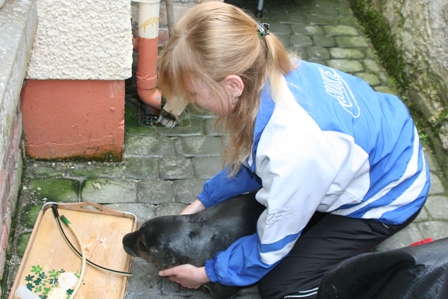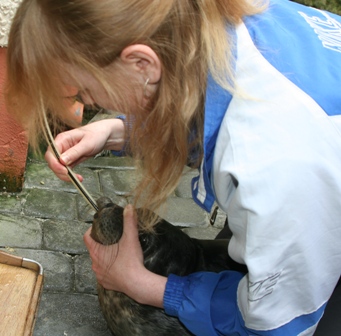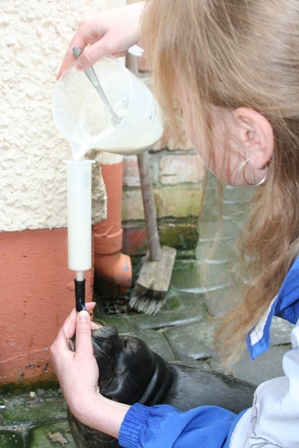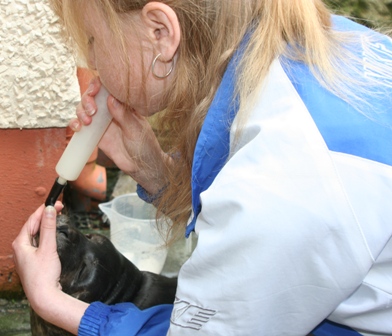If the pup is newborn, or of natural nursing age, and if it is showing any sucking response, it is worth trying it with a baby's bottle. Use a wide, flat teat, if possible. It may help to wrap a piece of sponge round the teat. (seal pups tend to push rather than pull on the teat, and they need a firm substrate for the muzzle to push against). Enlarge the teat hole by cutting a small cross. However, we have had success using a baby's bottle with only a few pups - most pups will reject the bottle, even if they have an active suckling response. If the bottle is not a success, do not wait, but tube feed the pup immediately. You can always try the bottle again.
To tube feed, the following items are needed:
- a feeding tube. We use medical feeding tube or other intubation tubing of external diameter 9-10mm, internal diameter about 7mm, and length about 14 inches (36-37 cm). If you have cut the tube from a longer piece, round off the end of the tube by heating with a match. Rubber tubing (as used for dogs) is too floppy, and not recommended, since the pup may bite through it. With a very small or weak pup a much thinner and softer tube ('lamb feeder') may be used (these are obtainable from veterinary practices).
- a funnel for attaching to the tube. We use a 50mm funnel supplied with a lamb feeder. This has a narrow top suitable for applying pressure with the mouth to push the milk down the tube. These funnels are supplied with a plunger. Some people use the plunger to push the milk down the tube. We find the plunger is troublesome, and don't use it.
- Any medication in liquid form in a small separate container. If medication is in tablet form, grind it to a powder and dissolve in a little water.
- The prepared milk, with enzymes mixed and at the correct temperature, and a fork to stir the milk if necessary.
First of all, prepare the milk formula, heat it to the correct temperature and add the enzymes.
Next, prepare the tube. We suggest that just before feeding the tube be soaked in hot water to soften it, and then wipe the outside of the tube with a kitchen towel soaked in cooking oil.
Collect on a tray all the feeding items needed, i.e. the tube, funnel, medication and milk.
Place the tray beside the pup, but in such a position that you won't knock it over while getting the pup into feeding position. Secure the pup by gently, but firmly, placing your hand against the back of its neck (thumb on one side of the neck, fingers on the other), and kneel behind the pup, with the pup held securely between your knees (do not put your weight on the pup). Then with one hand (if you are right-handed, use the left hand here) hold the pup's muzzle, with your thumb on top of the muzzle and the fingers underneath. (Wear a thin leather gove at first, until you are confident of not being bitten). Raise the pup slightly so it's head is stretched slightly up and you can see it's throat clearly. If the pup struggles, try to tuck its flippers in between your knees.

These photos are of visiting student Ira Trukhanova, from St Petersburg University in Russia, feeding Piccolo - July 2008. She is not wearing any glove, because Piccolo is very docile and does not bite at all.
When the pup is held securely, reach for the tube (with your right hand, if right-handed). We find it difficult to manouvre the tube in gloved hand, so we do not use a glove for this hand. Gently insert the tube into the pup's mouth (we fo slightly to the right side of the mouth). If the pup doesn't open its mouth, try touching the angle of the mouth. Gently push the tube ahainst the lips until the pup opens its mouth, and then quickly insert the tube, and feed the tube down and into the oesophagus. Until the pup is used to this, it will gag and probably struggle slightly, so be prepared, but be firm. With a very small pup (less than about 9-10 kg), 37 cm may be too long, and the pup may struggle until you bring a little of the tube out again.

As the tube slips down, watch the pup's throat. If the tube is correctly in the oesophagus, you should see the bulge of the tube beneath the skin. If you have someone with you, ask them to see if they can feel the tube. If you cannot see or feel the tube, especially in a young pup, you may have the tube in the trachea instead of in the oesophagus. If in doubt, take the tube out and start again. When you are sure the tube is in the oseophagus, check that the pup is breathing normally. Do not let go of your end of the tube - enough should always protrude from the pup's mouth so there is NO DANGER of the pup swallowing it.
When the tube is in place, insert the funnel into the top of the tube. First pour any medication (in liquid form). This will just pour down the tube. Then pour some feed into the funnel. The formula will be too thick to flow down the tube of its own accord, and so then put your lips to the tube and express the milk by blowing gently down the tube. Add more milk before you judge the tube to be empty (try not to blow air into the stomach). If the milk will not pass through the tube, it is possible that the end of the tube has become clogged with tiny bits of fish or bone (this tends to happen if you are using blended fresh fish, which is why we usually use tinned sardines!). In that case you need to take the tube out, clear the end the tube ad re-insert the tube to continue.


When the desired amount of milk has been fed, gently blow the last milk into the stomach and then draw the tube out. It is important psychologically for the pup that the feeding process should be as calm and stress-free as possible. Depending on the pup's reaction, we then usually stay with the pup briefly, soothe it and sit beside it. Some pups may try to suck on something immediately after feeding. If the pup tries to suck on our boots, trousers or jacket, we let it do this (eg Tara, Evie, Emil), or if it wants a surrogate, we try to provide one (eg Lora always suckled on a old door stop). Facilitating suckling seems to calm the pup and may help to make the feeding experience slightly more 'normal' for the pup. Suckling also creates alkaline saliva, which aids in the start of the digestion process.
After feeding, wash the tube, funnel, jugs, bottled, teats and blender thoroughly in hot water and washing-up liquid. Store plastic or glass parts in sterilising fluid (such as is used for babes' bottles).
